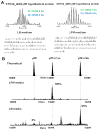Top-down proteomics in health and disease: challenges and opportunities
- PMID: 24723472
- PMCID: PMC4100610
- DOI: 10.1002/pmic.201300432
Top-down proteomics in health and disease: challenges and opportunities
Abstract
Proteomics is essential for deciphering how molecules interact as a system and for understanding the functions of cellular systems in human disease; however, the unique characteristics of the human proteome, which include a high dynamic range of protein expression and extreme complexity due to a plethora of PTMs and sequence variations, make such analyses challenging. An emerging "top-down" MS-based proteomics approach, which provides a "bird's eye" view of all proteoforms, has unique advantages for the assessment of PTMs and sequence variations. Recently, a number of studies have showcased the potential of top-down proteomics for the unraveling of disease mechanisms and discovery of new biomarkers. Nevertheless, the top-down approach still faces significant challenges in terms of protein solubility, separation, and the detection of large intact proteins, as well as underdeveloped data analysis tools. Consequently, new technological developments are urgently needed to advance the field of top-down proteomics. Herein, we intend to provide an overview of the recent applications of top-down proteomics in biomedical research. Moreover, we will outline the challenges and opportunities facing top-down proteomics strategies aimed at understanding and diagnosing human diseases.
Keywords: Human disease; Mass spectrometry; PTMs; Proteomics; Systems biology.
© 2014 WILEY-VCH Verlag GmbH & Co. KGaA, Weinheim.
Conflict of interest statement
None.
Figures




References
-
- Sabido E, Selevsek N, Aebersold R. Mass spectrometry-based proteomics for systems biology. Curr Opin Biotechnol. 2012;23:591–7. - PubMed
-
- Drake TA, Ping PP. Proteomics approaches to the systems biology of cardiovascular diseases. Journal of Lipid Research. 2007;48:1–8. - PubMed
-
- Altelaar AFMJ, Heck AJ. Next-generation proteomics: towards an integrative view of proteome dynamics. Nat Rev Genet. 2013;14:35–48. - PubMed
-
- Patterson SD, Aebersold RH. Proteomics: the first decade and beyond. Nat Genet. 2003;33 (Suppl):311–23. - PubMed
-
- Yates JR. Mass Spectrometry as an emerging tool for systems biology. Biotechniques. 2004;36:917–9. - PubMed
Publication types
MeSH terms
Substances
Grants and funding
LinkOut - more resources
Full Text Sources
Other Literature Sources
Miscellaneous

